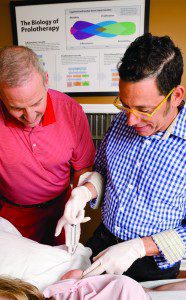By Caring Medical and Rehabilitation Services


Prolotherapy: a natural regenerative injection treatment stimulates the body to repair tissues that do not normally heal well on their own.
Muscles, for example, are enriched with an excellent blood supply, are beefy red in color, and consequently heal well on their own after injury. Conversely, joint-supporting structures such as cartilage, tendons, and ligaments are white in color with a very poor blood supply. The menisci, labrum, and even the discs in the spine are primarily white. When these white structures are torn, degenerated, or injured, they do not heal well without some additional assistance; hence the need for Prolotherapy or proliferative (“Prolo” meaning “to grow”) injection therapy. (See X-ray.)
Prolotherapy
The injections done during a Prolotherapy treatment are given into and around the weakened or injured area(s) of the body to, in essence, “weld” it back together. (See Picture.) Traditionally, this therapy utilizes solutions containing the naturally-occurring sugar in the body, d-glucose (or dextrose), in combination with additional hormones, nutrients, or a fatty acid, depending on the nature and severity of the injury. A serious injury or a severely arthritic joint may benefit from a more advanced form of Prolotherapy using a person’s own repair cells.
Stem Cell Therapy used for treating chronic pain
Long-standing degenerated tissues, such as tendons (tendinosis) or bone-on-bone arthritis, are deficient in repair cells, thus requiring additional cells to accelerate healing or regeneration.
Modern techniques allow a person’s own bone marrow and/or fat (lipoaspirate) cells to be extracted in order to obtain progenitor cells or stem cells. These cells have an extraordinary capability of replenishing cartilage, ligament, or tendon cells. (See Figure.) This type of natural injection treatment gives the body a chance to make new cells by directly supplying the extracted repair/stem cells to the deficient area.
How many treatments are required? Most patients require three to six sessions, depending on the severity of the case and the technique of the physician. Prolotherapy injections are typically given monthly allowing the body time to regenerate new tissue. Stem Cell Therapy sessions are typically spaced six to eight weeks apart. Individual responses vary.
Natural Joint Rejuvenation Versus Surgery
Most people intuitively understand that surgery for chronic pain should be the treatment of last resort. Surgeons even encourage patients to try conservative therapies before receiving surgery. Natural injection therapies for joint rejuvenation, namely Prolotherapy and Stem Cell Therapy, can be utilized for number of conditions, including osteoarthritis, back pain, tennis elbow, meniscus tears, labrum tears, herniated and degenerated discs, migraine headaches, sports injuries, joint instability, and a host of other conditions. With a comprehensive technique and patient participation efforts, Prolotherapy is generally 90% successful at keeping these patients from needing joint replacement and other surgical interventions.
PROLOTHERAPY SPECIALISTS:
Ross A. Hauser, M.D.
Danielle R. Steilen, MMS, PA-C
Timothy L. Speciale, DO
(239) 303.4069 | www.CaringMedical.com
 Southwest Florida's Health and Wellness Magazine Health and Wellness Articles
Southwest Florida's Health and Wellness Magazine Health and Wellness Articles
